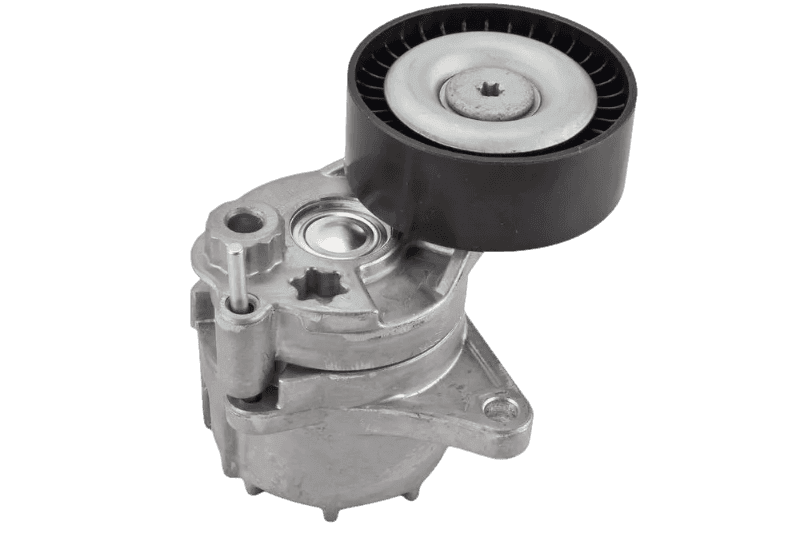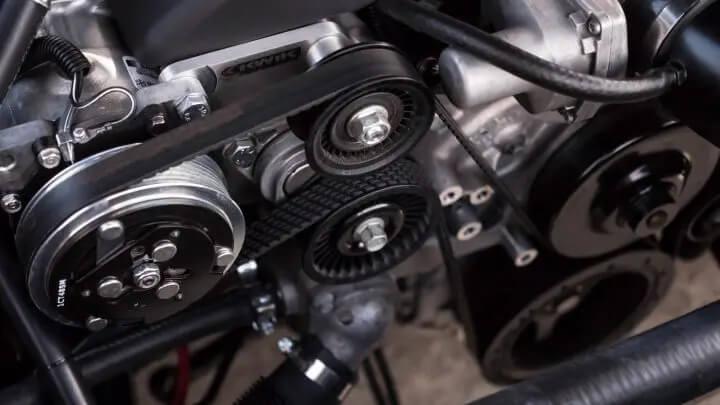Why Is Your BMW Making Pulley Noise & How Can Resolve It?
You’re driving your prized BMW, relishing the luxury and performance that this iconic brand is known for. But suddenly, amidst the purr of the engine, there is an unexpected, unsettling noise from under the hood. You’ve just entered the world of BMW pulley noise, a scenario every BMW owner hopes to avoid.
But what exactly is a pulley? What does it mean when your BMW starts making those peculiar sounds? And why should you care?
Let’s embark on a journey through the intricate world of BMW pulleys and explore why understanding and addressing pulley noise is not just a matter of luxury but a necessity for preserving the heart and soul of your ultimate driving machine.

What is BMW Pulley?
Before we dive into the world of BMW pulley noise, let’s start with the basics. A pulley, in essence, is a deceptively simple yet incredibly crucial component within your BMW’s intricate machinery. It’s a wheel with a groove, a seemingly modest player in the grand orchestra of your vehicle’s performance. But make no mistake, it plays a pivotal role in transmitting power, ensuring that your BMW runs smoothly and efficiently.
What is BMW Pulley Noise?
BMW pulley noise is the mysterious and often disconcerting symphony of sounds emanating from your engine compartment. These noises can be as diverse as the BMW models themselves, from a high-pitched squeal to a persistent chirping or a subtle, nagging whine. It’s your BMW’s way of telling you that something isn’t quite right under the hood.
Symptoms of BMW Pulley Noise
How do you recognize the ominous presence of BMW pulley noise? It often manifests as those peculiar sounds – the squeals, chirps, and whines that may intensify during acceleration or when your engine bears a heavier load. These noises serve as your BMW’s distress call, alerting you to a problem that demands your attention.
Types of Pulleys in BMW Cars
Let’s dive into the different types of pulleys that keep your BMW running smoothly. These might not be the most talked-about parts, but they quietly play vital roles in your driving experience:
- Idler Pulley: Think of the idler pulley as the “belt supervisor” in your car. Its job is simple but crucial as it maintains the right amount of tension in the drive belt. This belt connects various parts of your engine, and the idler pulley ensures it’s just tight enough to work without any hitches.
- Water Pump Pulley: The water pump pulley is like your engine’s cooling manager. It’s in charge of circulating coolant to prevent your engine from getting too hot. In the world of engines, staying cool is key, and this pulley helps your engine do just that.
- Alternator Pulley: Consider the alternator pulley as your car’s electrical powerhouse. It’s responsible for producing electricity to charge your battery and keep all the electronic systems humming along. When this pulley is in good shape, your car’s lights, radio, and other gadgets work without a glitch.
- Power Steering Pulley: Ever marveled at how effortlessly you can steer your BMW? Thank the power steering pulley for that. Working in tandem with the power steering pump, it ensures you can turn the wheel with ease, making your driving experience smoother, especially in tight spots.
- Air Conditioning Compressor Pulley: Lastly, there’s the air conditioning compressor pulley, your partner in staying cool when the temperature soars. It ensures your AC functions efficiently, so you can enjoy a comfortable ride even on the hottest days. If your cabin has been unusually noisy or cooling feels weak, it could also relate to BMW Air Conditioning Problems where pulleys directly affect AC performance.
Getting acquainted with these pulleys is like meeting the unsung heroes behind the scenes of a movie. They might not be in the spotlight, but they’re vital for a seamless performance. Understanding their roles helps you appreciate their importance in keeping your BMW running smoothly.

Common Causes of BMW Pulley Noise
Let’s get to the bottom of why your BMW’s pulleys are making those bothersome sounds. No need for complicated terminology here as we’ll explain it simply and clearly:
- Worn Pulley Bearing: Think of the pulley bearing as a small but crucial part of the pulley system. Over time, just like your favorite pair of shoes, it can wear out. When it does, it starts making noise, much like a creaky door hinge in need of some oil.
- Misaligned Pulley: Imagine your pulley as a wheel on a bicycle. If it’s not perfectly aligned, it’s like having a wobbly wheel as you ride. This misalignment creates friction, leading to noise, similar to the bumpiness you’d feel driving on a rough road.
- Damaged Pulley Belt: The pulley belt is like the lifeline of your engine, connecting all its moving parts. If this belt gets damaged or wears down, it can slap against the pulleys, causing noise. It’s a bit like a frayed belt on your pants, it’s time to replace it to stop the racket.
- Worn Pulley Bushing: Think of the pulley bushing as a cushion supporting the pulley’s movements. Over time, much like the padding on your favorite chair, it can wear out. When this happens, it can make the pulley wobble and generate noise, similar to a chair that wobbles when you sit in it.
- Loose Pulley Bolt: The pulley bolt acts as the anchor, keeping everything securely in place. If it’s not properly tightened, it’s like having a loose screw in a piece of furniture. This can result in vibrations and, of course, noise. It’s like a door handle that jiggles, it needs to be properly secured.
Understanding these common causes of pulley noise is your first step in solving the issue. In the upcoming sections, we’ll explore how to diagnose this noise and provide solutions to get your BMW running quietly and smoothly again.
How to Diagnose BMW Pulley Noise?
Let’s roll up our sleeves and get to the bottom of that BMW pulley noise. No need for technical talk, we’ll explain it clearly and help you get back to a smooth ride:
Listen for Unusual Noises: Start by turning off the radio and rolling down the windows. While your engine is running, listen carefully for any odd sounds like squealing, chirping, or whining coming from the engine compartment. These noises are your BMW’s way of telling you that something’s amiss.
Inspect the Pulleys: Next, pop the hood and take a look at the pulleys. You don’t need to be a mechanic, just look for any obvious signs of wear or damage. This could include things like visible cracks, frayed belts, or pulleys that don’t look quite right. Trust your instincts here, if it looks off, it probably is.
Use a Stethoscope: If the noise isn’t immediately obvious, here’s a trick: grab a mechanic’s stethoscope (you can find one at an auto parts store). With your engine running, carefully place the stethoscope on each pulley, one at a time. If the noise persists alongside steering stiffness or whining, it could also overlap with BMW Steering Wheel Noise problems. Listen closely, you’ll be able to hear if a particular pulley is making more noise than it should. It’s a bit like being a detective, narrowing down the culprit.
How to Fix BMW Pulley Noise?
You’ve identified that pesky pulley noise in your BMW – now it’s time to put things right and restore your car’s peaceful purr. We’ll walk you through the solutions, keeping it straightforward and practical:
Replace the Worn or Damaged Pulley: If you’ve pinpointed a pulley with a worn-out or damaged bearing, it’s time to swap it out. Much like changing a flat tire, replacing a pulley isn’t overly complex. New pulleys are readily available at auto parts stores, and with some basic tools and patience, you can have your BMW’s pulley system back in shape.
Realign the Pulley: Imagine your pulley as a wheel on a bicycle – if it’s not perfectly aligned, it can lead to friction and noise. In such cases, a simple realignment can work wonders. This is like getting your wheels back in line for a smoother ride. Adjusting the pulley position to ensure it’s straight and true can often eliminate the noise issue.
Replace the Damaged Pulley Belt: Is your pulley belt frayed or damaged? It’s akin to a worn-out shoelace – it’s time for a fresh one. A new pulley belt can be found at an auto parts store, and replacing it is a bit like threading a new lace through your sneakers. Once it’s securely in place, you’ll notice the difference – smoother and quieter driving.
Replace the Worn Pulley Bushing: The pulley bushing is like the cushion that supports the pulley’s movements. Over time, it can wear out, much like the padding on your favorite chair. Replacing it is as straightforward as swapping an old cushion for a new one. Once done, your pulley will operate without wobbling and producing noise.
Tighten the Loose Pulley Bolt: The pulley bolt is like the anchor keeping everything secure. If it’s not tightly fastened, it’s like a loose screw in a piece of furniture – it can lead to vibrations and noise. A simple tightening job can make all the difference, restoring stability and quietness.
By following these practical steps, you can effectively address BMW pulley noise and get your car back to a peaceful, smooth ride. No need for complex maneuvers – just some basic maintenance to ensure your BMW runs quietly and efficiently once more.

Why is BMW Pulley Noise a Problem?
You might wonder, why should you be concerned about these peculiar noises. Well, that’s a valid question. Beyond the initial annoyance and discomfort, BMW pulley noise can evolve into a full-blown problem with significant consequences. Ignoring it is akin to turning a deaf ear to your BMW’s plea for help.
Think of it this way: your BMW’s engine is a masterpiece of precision engineering, and each component is carefully designed to work in harmony. When pulley noise enters the scene, it’s like a discordant note in a symphony. It can lead to more than just an unsettling soundtrack to your drive; it can result in potential damage to essential engine components, compromising both performance and safety.
- BMW Idler Pulley Noise
Your BMW’s idler pulley is a vital part that keeps everything running smoothly. However, when it starts making noise, it signals a need for professional attention. Those squeaks or whining sounds often indicate a worn or damaged idler pulley, and fixing it correctly requires the expertise of a professional mechanic. Avoid DIY attempts and trust a skilled technician to replace the pulley, ensuring your BMW runs like new once more.
- BMW Tensioner Pulley Noise
In the precision symphony of your BMW’s engine, tensioner pulley noise disrupts the harmony. This squeaky or whining sound is often a sign that the tensioner pulley needs professional attention. Like a conductor maintaining an orchestra’s rhythm, a mechanic can expertly replace the tensioner pulley. Trust the expertise of a professional and the quality parts they use to ensure your BMW’s performance remains quiet and efficient.
- BMW Crankshaft Pulley Noise
When your BMW’s crankshaft pulley starts making noise, it’s a signal that a professional tune-up is in order. That rumbling or rattling sound can indicate a problem with the crankshaft pulley, affecting your engine’s performance. It’s crucial to diagnose and address this issue correctly. For the replacement of the crankshaft pulley, trust a skilled mechanic to ensure a smooth and quiet drive. Professional expertise is the key to keeping your BMW in top condition.
When your BMW’s idler, tensioner, or crankshaft pulleys start causing a ruckus, it’s a clear call for professional intervention. These often-overlooked components are vital for your BMW’s seamless performance, and entrusting the task to a skilled mechanic ensures that issues are correctly diagnosed and addressed. By doing so, you preserve the quiet, efficient driving experience you cherish. So, in the face of pulley troubles, do not hesitate to turn to professional assistance. This not only extends your BMW’s lifespan but also keeps the essence of pure driving pleasure alive.
